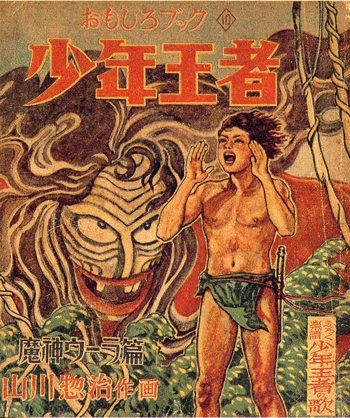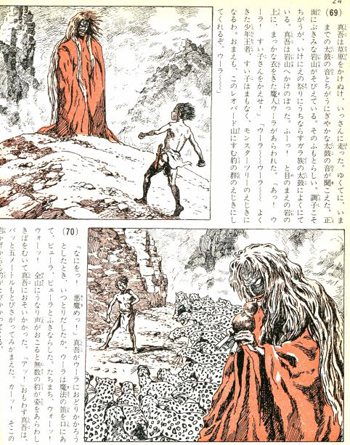

In the late 1940s and '50s, there was a mixed genre of picture narrative in Japanese youth magazines that, as far as I know, does not have its own name. It usually appeared under the rubric of “emonogatari” (pronounced “eh-mono-gatari”), the equal parts image and text “picture stories” that had been popular since Yamakawa Sōji’s work for Shōnen Club during the war, and particularly after his hit Shōnen King (Shōnen Ōja) in 1947. Like that title, many early emonogatari were conceived as print versions of kamishibai, in which rectangular image and expository text were coupled like the picture cards and oral narration of that theatrical art form.
The popularity of emonogatari led to the creation of numerous magazines dedicated almost wholly to the medium, main amongst them Adventure King (Bōken ō), Omoshiro Book, Adventure Book (Bōken bukku), Thrilling Book (Tsūkai bukku), and most importantly Action Adventure Stories (Bōken katsugeki bunko), often abbreviated as Bōkatsu, before renamed Shōnen Gahō in 1950. Even into the early 1950s, “youth magazine” meant emonogatari and illustrated prose fiction. The artists of the former were often hired for the latter, and in most cases both artist and writer were either top names from before the war or their direct acolytes. Only beginning in the mid 1950s did manga begin to dominate Japanese youth magazines. While this can be seen in the increasing proportion of pages given to comics, it can also be seen in emonogatari themselves. Beginning with Nagamatsu Takeo’s (1912-61) Golden Bat for Bōkatsu in 1948, an adaptation of his super popular prewar kamishibai, one finds more and more emonogatari incorporating many of the formal elements and humor of the rival medium of comics – and not just Japanese comics. In Nagamatsu’s time, this was probably for purely aesthetic reasons, to access some of the arabesque flow of American comic layouts, versus the static grid that reigned in emonogatari and manga alike. But by the '50s, when comic-ized emonogatari begin to proliferate, it’s presumably to compete with the rise of manga.

Like I said, as far as I know, there is no standard name for this hybrid medium. The magazines and furoku booklets (premiums) that carry such work advertise them as “emonogatari,” but if one opens them looking for prose coupled with framed rectangular pictures, they will be disappointed. There is still a heavy textual component, with strong expository qualities, but now much more of the story is shown rather than told. Still standard is the naturalistic illustrational style that emonogatari derived from 1930s illustrated prose and kamishibai, but now less sharp in line, sometimes clunky, less tableaux-like and more fractured into dramatic “cinematic” details. The character and narrative types are also fully in the tradition of emonogatari, kamishibai, and prewar juvenile fiction. But there is increasing humor, some of which seems derived from the movies, but many of the reflexive gags are clearly inspired by Tezuka Osamu and his kin. The most obvious markers of comics’ influence, however, are these works’ dynamic paneling, speech balloons, and sound effects. Much of this imported formal language suggests American comics over Japanese: round panels, big panels, shaped panels, figures that are too fleshy to be from '30s Japan, large cartouches of text, and coloring (when there is coloring) that is often close in palette to contemporary American comics. At least one youth magazine at the time – Manga King (Manga ō) – included translations of American titles like Durango Kid, Lone Ranger, and Reed Crandall-era Blackhawk, all licensed through the NANA (North American Newspaper Alliance) news syndicate. One emonogatari Western from 1953 in the monthly Tankai is advertised as a “talkie action emonogatari,” as if the insertion of speech balloons and serial imagery signified sound cinema. But obviously the major influence was comics, Japanese and especially American.

How about the name “emanga” (pronounced “eh-manga”), literally “picture comics,” for this emonogatari that is clearly no longer “print kamishibai,” but instead an amalgam of emonogatari, manga, and American comics? This probably will not go down with Japanese historians. There is little writing in general on this topic, but what does exist tends to describe these late stage emonogatari in fairly narrow populist and nationalistic terms. Oftentimes they are seen as missing links in the evolution of “Japanese popular culture” from street theatre kamishibai of the prewar and immediate postwar periods, to sixties shōnen manga and young adult gekiga. As such, they tended to be regarded as vehicles for transporting the sensibilities of a simpler and purer age into the pop culture of the high growth period. There’s some ground for this view. A few of the relevant artists began as kamishibai artists before becoming manga stars in the '60s and '70s, like Yoshida Tatsuo and Kojima Gōseki. There is also some continuity in drawing style, storylines, and character types. Still, it’s poor history to narrate the evolution of Japanese youth culture in the 1950s without taking into account the impact of American culture, which continued to flood the market and shape domestic production well after the Occupation. One should also not forget the collaborations between publishers, toy manufacturers, and broadcast networks to capitalize on the growth and affluence of the Japanese baby boomer generation. No mass entertainment form survived into the high growth era without being reformatted in order to succeed as a commodity in the age of mass visual media. The transformation of emonogatari into emanga, as I see it, was a result of those forces, and expressed their influence clearly.
What follows is not meant to be a comprehensive or even representative picture of this genre. It’s provisional at best in terms of art history and fact. When I was first approached to write this column for TCJ, the idea was for reports of wild things I found in the library and bookstore. This essay is more in that spirit: less researched, more show and tell. I have only a general grasp of the history of this medium, gleaned from secondary sources (which are themselves spotty) and the handful of titles I have picked up in original and reprint in the past few months. To explain stylistic shifts in Japanese comics between the '50s and '60s, I know I’ll have to research the subject more thoroughly at some point in the future, particularly considering certain strands of gekiga are understood to have come out of these late stage emonogatari. For now, here’s a small selection of “emanga” that I happen to have on hand. These are not all famous, and I am jumping over many of the best known. Still, the four works here should give a basic sense of the features and breadth of the medium, and its evolution between the late '40s and late 1950s, at which point it either disappears, depending on one’s view, or gets absorbed into the expanding language of '60s manga.
One of the reasons I am sharing this essay in its hacked-out state is that I need help with the comparative research. I know only the bare bones of American comics history. If anyone reading this thinks they know what non-Japanese material these artists are looking at, please share. The more exact the identification the better: artist, title, year, and even issue number if you can. General thoughts are also good. I won’t be able to dig into comic books until I return to the United States next summer. Any leads would make my job much easier, and would be most appreciated.
(Continued)






